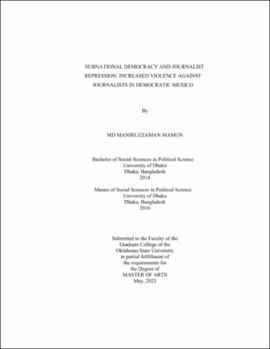| dc.description.abstract | Existing theories of democracy and repression expect higher repression in unconsolidated democracies like Mexico. This project examines whether executive constraint, executive competition, or both, or neither matters in reducing journalist repression. I theorize that increased political competition at the local level created an open environment for journalists in Mexico, and that opening made journalists more active in covering critical news. As this critical media role also challenges the authority, and the local authorities are still not constrained sufficiently, local-level governments use repression against threatening journalists. The study expects that increasing competitiveness should have a large and positive relationship with journalist repression at low levels of executive constraint. Conversely, when the executive constraint is high, the effect of competition on repression should be smaller. By employing a comparative case study of the Mexican states, the study partially finds support for the theory. The findings show that most killings are concentrated in high executive constraint and high competition, and more competition leads to more killings given the same amount of constraints. No killings in low constraints, regardless of competitiveness. Finally, No killing in the low constraint states, and all the killings in the high competition. Competition does appear to be a driver of journalist repression, while constraints in the form of divided government do not appear to restrain repression. This surprising result may be partially explained by the high level of organized crime in some Mexican states, as additional data analyzed here suggests. The study also seems to support the “More Murder in the Middle” (e.g., Fein, 1995) hypothesis. I also studied four case studies to complement the major findings. Protection not being assigned or withdrawn before the killing, questionable practice of investigation, or cases being buried implies the state government’s involvement in the killings and that executive constraints are not enough to protect journalists. The study suggests that executive constraints matter more than the executive competition in reducing violence against journalists in newly democratized countries. The study also suggests that political competition without sufficient constraints in higher but unconsolidated democracies is dangerous for the safety of journalists. | |
